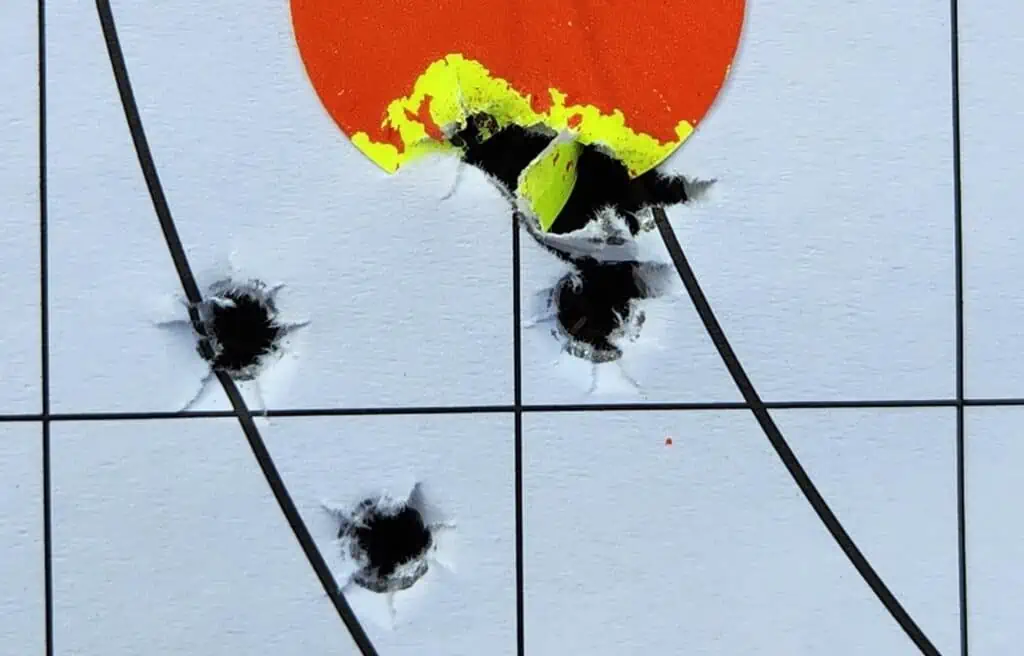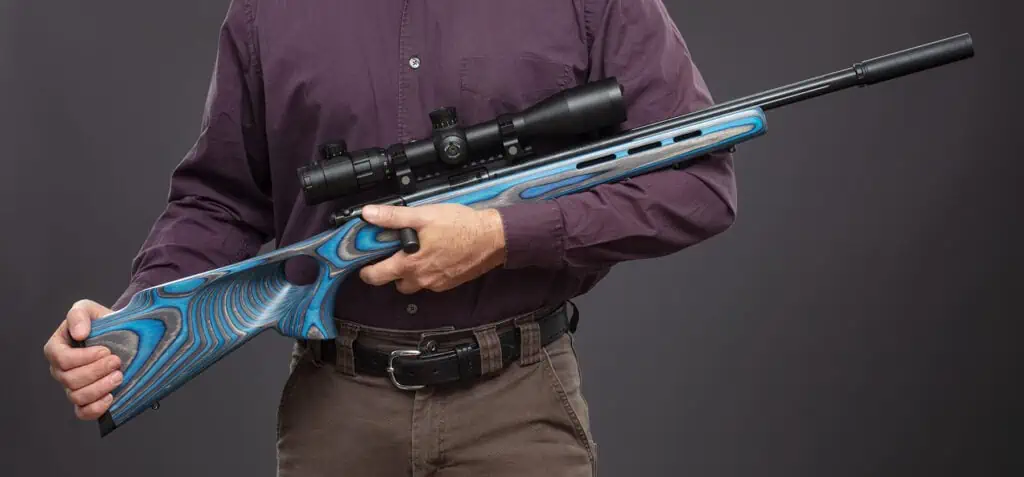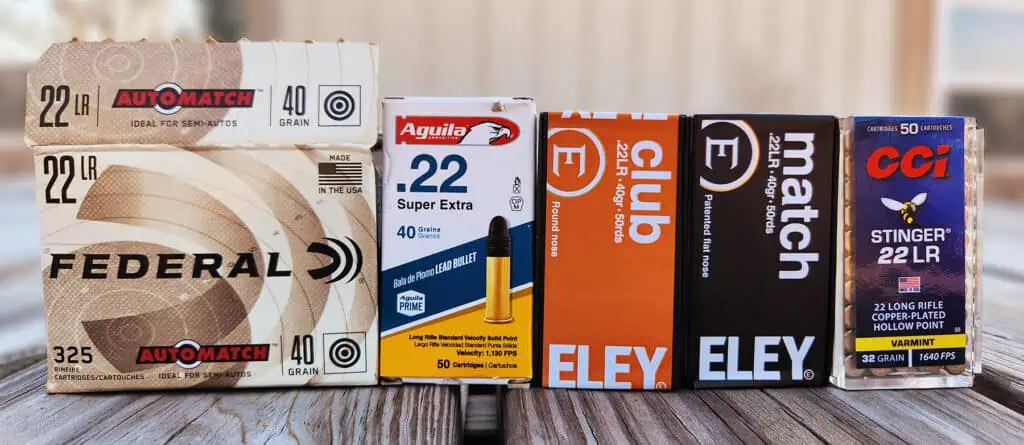.22 Long Rifle (or .22LR for short) is the closest we have to a “do it all” cartridge. From hunting for small game, to plinking, to target practice, to (limited) use in self-defense, it’s probably the most versatile cartridge on the market today. However, just like other larger calibers, not all .22LR ammunition is created equal.
So, when it matters most – what are your best options for accurate, 22LR match ammo?
Our Picks – Best 22LR Match Ammo
1.) Eley Club and Eley Match
Eley’s Club offers elite performance at a slightly lower price point than their top of the line Eley Match line-up of 22LR rounds. Eley produces ammo that’s considered among the finest in the world but you’ll likely notice it’s more expensive than match rounds produced by other manufacturers. In a lot of ways, you get what you pay for. In the match world, what’s another couple pennies per round if performance really matters?
2.) Aguila Match Ammo
While not the most notorious ammo producer, Aguila’s rimfire performance is notable and quite respected. In our tests, the Super Extra and Aguila Match rounds both performed admirably. The ammo consistently groups and cycles well. Relative to the Eley, the performance is comparable and the price point is typically a little lower.
3.) Federal Automatch

Federal Automatch is one of the most common match rounds out there for 22LR shooters. Its performance is good but not excellent compared to the other top-end match loads out there. If you want something out of the box you can trust for reliable performance and minimal chance of cycling headaches, Federal AutoM atch is a great choice.
From here, we’ll explain a little bit about what makes match ammo different and how we arrived at our picks. We’ll include independent test results from two shooters, Kevin Creighton and Oleg Volk. Read on to hear what firearms they used and how various 22LR rounds performed for them at the range.
What Makes .22 Match Ammo Better Than Standard Rounds?
It’s not so much that the components in a round of .22 match ammo are different than in a normal .22 round, it’s consistency that sets it apart.
Bullets
.22 Match ammo typically has bullets that are shaped the same as bullets inside of a standard .22 round. For the most part, the bullets used in .22 match-quality ammunition are lead, round-nosed projectiles that are not designed to expand on impact. There are exceptions to this, though, such as Federal’s HV Match round. The HV load is both higher-quality and designed to open up on impact.
Cases
As with centerfire match ammunition, more care and attention is put into making the brass for a round of .22 match ammunition. Also, the bullet seating depth (how far the round is pushed into the top of the case) is more consistent than with standard .22 ammunition.
Powder
A round of .22 match ammo will have a more consistent powder charge than a normal .22 round.
Why use .22 Match Ammunition?
The primary reason for .22 match ammunition is right there in the name: matches. Competition shooting is the main reason to use this ammo over standard .22 ammunition. .22 match-grade ammo is the ammunition of choice for all kinds of competition, from the fast-growing sport of .22 Precision Rifle to Rimfire Challenge to regional Smallbore Rifle matches to high-level Olympic competitions. But just how good is .22 match ammo versus standard .22 ammunition?
Let’s find out.
To test the quality of .22 ammunition, we shot a variety of different “match” rounds through a Savage B-22 rifle that has been extensively upgraded by savagegunsmithing.com. Using a target that was fifty yards away, we shot four five-round groups of each type of ammo and measured each group center to center. We also measured the velocity of the ammo using a Pro Chrony chronograph set up at the muzzle. We recorded the minimum and maximum velocities of each type of ammo. In addition, we measured the standard deviation of the velocities to determine the consistency of each type of ammo. A lower standard deviation means more consistent velocities. This, in turn, means more consistent results on the range.
We tested six different types of .22 match ammo, and then compared them to a high-quality, “standard” .22 round.
The match-grade rounds we tested were:
- Aguila 40 Grain Round Nose Lead .22LR
- Eley 40 Grain Round Nose Lead .22LR
- Wolf 40 Grain Round Nose Lead .22LR
- CCI Green Tag 40 Grain Tag Round Nose Lead .22LR
- Federal HV Match 40 Grain Tag Round Nose Lead .22LR
- Federal AutoMatch 40 Grain Tag Round Nose Lead .22LR
The baseline, “standard” round we used was the 40 grain CCI MiniMag, a very popular general-purpose .22 cartridge.
Test Results
Aguila 40 Grain Round Nose Lead .22LR
Average Velocity: 1070 fps
Minimum Tested Velocity: 1027 fps
Maximum Tested Velocity: 1096 fps
Standard Deviation: 12.68
Average Group Size at 50 Yards: 0.67 Inches
Eley 40 Grain Round Nose Lead .22LR
Average Velocity: 1095 fps
Minimum Tested Velocity: 1081 fps
Maximum Tested Velocity: 1107 fps
Standard Deviation: 7.55
Average Group Size at 50 Yards: 0.68 Inches
Wolf 40 Grain Round Nose Lead .22LR
Average Velocity: 1046 fps
Minimum Tested Velocity: 1027 fps
Maximum Tested Velocity: 1107 fps
Standard Deviation: 11.9
Average Group Size at 50 Yards: 0.73 Inches
CCI Green Tag 40 Grain Round Nose Lead .22LR
Average Velocity: 1076 fps
Minimum Tested Velocity: 1062 fps
Maximum Tested Velocity: 1093 fps
Standard Deviation: 9.27
Average Group Size at 50 Yards: 0.81 Inches
Federal HV Match 40 Grain Round Nose Lead .22LR
Average Velocity: 1196 fps
Minimum Tested Velocity: 1185 fps
Maximum Tested Velocity: 1228 fps
Standard Deviation: 12.33
Average Group Size at 50 Yards: 0.93 Inches
Federal AutoMatch 40 Grain Round Nose Lead .22LR
Average Velocity: 1196 fps
Minimum Tested Velocity: 1174 fps
Maximum Tested Velocity: 1209 fps
Standard Deviation: 10.83
Average Group Size at 50 Yards: 0.75 Inches
For comparison, here are the results for CCI MiniMag ammunition:
Average Velocity: 1248 fps
Minimum Tested Velocity: 1225 fps
Maximum Tested Velocity: 1272 fps
Standard Deviation: 14.24
Average Group Size at 50 Yards: 1.06 Inches
More Bang For Your Buck, But Also More Bucks For Each Bang
Based on our testing, there is a clear difference between standard .22 ammunition and .22 match ammo. All of the varieties of match-grade ammunition we tested shot tighter groups and had more consistent velocities than standard .22 ammunition. However, that accuracy and consistency does come with a price. Match-grade .22LR costs more per round than regular .22 ammunition. Is that extra money worth it for plinking or everyday use? Probably not. However, if accuracy and consistency are on the line, .22 match ammo should be your “go to” ammunition.
Once upon a time, my friends and I were shooting two versions of 10-22 action: a Department Store Special with a basic 4x scope and a Volquartsen custom heavy barrel with a nice high-power optic. While the better rifle shot noticeably smaller groups even at 25 yards, we found that the cheaper gun shot better with Eley Practice Match, the cheapest of their offerings, than the expensive gun did with bulk .22 cartridges. Even at that short distance, bulk .22 shot a 4″x6″ oval spread, CCI Mini Mags short about 1″ group, and Eley bullets hit so close to each other the holes overlapped. That was my first lesson about the importance of ammunition quality.
Since then, I’ve discovered that most guns shoot match ammunition better than other loads, but that’s not always true. A Serbian M77 rifle shot better with cheap surplus ball than with any expensive match loads. It always pays to try a variety of cartridges first, then pick the most common and least expensive load of those that shot consistently well.
Oleg’s 22LR Match Tests

I have not shot my Savage 93 Mk.2 in quite some time, so I pulled it out of the safe to test with currently available ammunition. Set up in a Boyd’s laminate varmint stock, with a sound muffler and an inexpensive but decent older Primary Arms 4-16x scope, this rifle should be easy to shoot to its full potential. Hopefully, Appleseed rifle clinics taught me something! Unfortunately, shooting with a Vortex 3-15x the previous days spoiled me for lesser optics: at least some of the potential inaccuracy came from the slight geometric distortion in the PA scope. On the plus side, it was adjustable for parallax, so my degree of aiming error should have been minimal. In any case, the point of testing ammunition is not to determine which load is better in general, but rather which loads work well in my particular configuration of rifle, optic, and other accessories.
Since my shooting bench is 60 yards from the target board, the testing was done at that range for convenience. The rifle was originally zeroed at 100 yards with a different sound suppressor, so the initial impacts were high and to the right. I corrected windage but didn’t touch the elevation: having the group form away from the point of aim removed the chance of the reference mark getting obliterated midway through my string of fire. I used a sandbag for the wide, flat forend, and a smaller beanbag under the stock. The test had to be done in the morning to avoid higher winds of the afternoon.
22LR Ammo Tested

The ammunition Oleg tested, in order:
- Federal Automatch 40 Grain
- Aguila Super Extra 40 Grain
- Eley Club 40 Grain
- Eley Match 40 Grain
- CCI Stinger hypervelocity 32 Grain
Federal’s Automatch 22LR
Federal Automatch spread has been consistently around 1.5 MOA. Some rifles shoot this load better than others, so it’s worth including in your own tests.
Aguila Super Extra
Aguila Super Extra did reasonably well for a budget load: 1.7 MOA. This group size has been consistent in several rifles, so I am going to assume that’s the limitation of the load consistency. Better shooters with more accurate rifles on windless days will likely do better, but sub-MOA round it isn’t — in my personal experience. It is perfectly adequate for all unscoped rifles and for handguns, but less so for match rifles.
Eley Club
Eley Club is the entry level offering from the high-end maker. It wasn’t surprising that it grouped inside of 0.75 MOA, as long as I did my job. Eley Club, just as the discontinued Eley Practice before it, delivers excellent value in a variety of my rifles.
Eley Match
My groups with Eley Match hovered between 0.9 MOA and 1 MOA. You would think that the more expensive load would perform better, but that wasn’t the case. We have two possibilities here: either this particular rifle shoots better with Club than with Match, which is possible. Another possibility is that my own skill level with the particular rifle isn’t much better than 0.75 MOA to 1 MOA, and the performance of very accurate ammunition is masked by my technique deficiencies. Being standard velocity, both of these sound suppress well, but Club is half the price of Match…so that’s my choice for accurate shooting.
Enter the Stinger
The last load under consideration was CCI Stinger, a very high velocity varmint cartridge. It has tested as less accurate in several of my guns. One varmint rifle manual specifically said to avoid it due to over-long case not fitting the tight match chamber. And — surprise of the day — this round also shot 0.75 MOA. It’s noticeably louder than Eley Club, so the slower bullet would be preferable for recreational shooting. However, shorter flight time means less wind drift and less drop at distance, making varminting easier. Hollow point bullet actually moves fast enough to expand, so for meat hunting Stinger wins.
With all those loads, I considered the best 5-shot groups I could make consistently to be definitive. Some of my shot strings produced groups almost twice as big, or else tight four-shot groups with a serious outlier. That was a function of my technique, which is why every load had at least five groups shot, and some had more than that. Again, my testing wasn’t designed to determine the best ammunition in the abstract, but rather which loads to use in this one particular rifle. For people with multiple rifles, it’s worth taping an ammunition recommendation note right next to the trajectory dope charts. Otherwise, how would we remember what’s the best varmint round for a rifle last shot years ago?
For folks who have one favorite rifle, it’s work making a comparison of the points of impact, along the lines of “at 50 yards, Eley subsonic is 1 inch low and 0.5 inch left compared to Federal Automatch to enable switching between different cartridges on the fly without re-zeroing with live fire.



